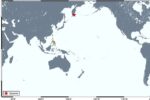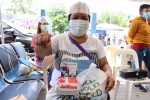WHO caution government in relaxing NCR COVID-19 curbs with healthcare system just ‘holding up’

SAN JUAN MAYOR OBSERVE VACCINATION (FILE PHOTO)
The World Health Organization on Tuesday warned the Philippines against relaxing COVID-19 curbs in National Capital Region that could overwhelm the healthcare system.
WHO Representative to the Philippines Dr. Rabindra Abeyasinghe said Metro Manila has 13.5 million people that will shift to Alert Level 4 in a new 5-step system that makes use of granular lockdown, which government hopes will increase business activity.
Abeyasinghe said while Metro Manila has 60 percent its target population vaccinated, this is not adequate at this point to relax quarantine positions.
“You may re-craft the terminology. But basically what we are advising is make sure that those restrictions are followed, that we don’t relax too much because we are not in a position where we can relax and experience a further worsening of this transmission level,” Abeyasinghe said told media in televised briefing.
“If there is a further increase in transmission levels, it can lead to an overwhelming of the hospital systems. That’s why we need to be very careful in calibrating how we respond to the current situation,” said Abeyasinghe.
“Our health systems are just holding up,” he reasoned.
Metro Manila’s new quarantine level will allow outdoor dining at 30-percent capacity, and indoor dining for small groups of fully immunized people, officials said.
Religious gatherings and personal care services will be allowed at 30% of building capacity, they added.
If successful, the same formula could be applied across the Philippines, which is battling one of Asia’s worst coronavirus outbreaks.
The shift in the government’s COVID-19 strategy could soon pave the way for limited face-to-face school classes and the reopening of indoor entertainment facilities in areas with low virus transmission and adequate hospital capacity.
The shift followed calls by some health professionals for tighter curbs to give stretched hospitals a breathing space.
“Up to now, cases are still increasing. It’s just like the Olympics, we are waiting for when we will hit a new record high,” Geneve Rivera-Reyes, a public physician said
Metro Manila’s overall infections in the past 30 days alone accounted for more than a fifth of the country’s total of 2.2 million cases, while overall deaths have reached 35,145.
At least 17 million of the Philippines’ 109 million people are now fully vaccinated against COVID-19, Malacañang said.
“We have made progress, but unfortunately, the progress in the Philippines has been painfully slow,” said WHO’s Abeyasinghe.
He noted that 3.6 million elderly people have not yet received a single COVID-19 shot.
Older adults account for 7 in 10 deaths due to COVID-19 locally, he added.
“This is unfortunate, it is unsatisfactory. It’s also a reflection of the inequity we are seeing that we are seeing globally happening… which we need to correct urgently,” Abeyasinghe said.
“We should not create inequity within the country when we are vaccinating people,” he urged authorities.






